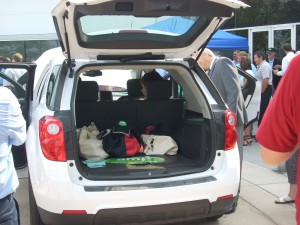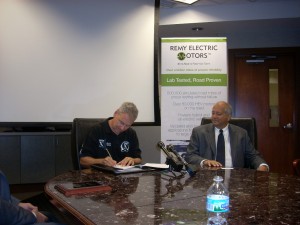The Ford Focus was unveiled last week at the International CES in Las Vegas. Below is Ford’s promotional video of the vehicle in action. As you can see, it looks just like a regular Ford Focus, except for the grille and lack of tailpipe. Ford plans to release four more electric vehicles as part of it’s electrification strategy. That is innovative thinking.
Press Release:
Information contained on this page is provided by companies via press release distributed through PR Newswire, an independent third-party content provider. PR Newswire, WorldNow and this Station make no warranties or representations in connection therewith.
SOURCE Ford Motor Company
DEARBORN, Mich., Jan. 7, 2011 /PRNewswire/ —
- All-new Ford Focus Electric is the first fuel-free, rechargeable passenger car from Ford and one of five new electrified vehicles Ford will deliver by 2013 in North America and Europe
- Focus Electric will offer a mile-per-gallon equivalent better than Chevrolet Volt and competitive with other battery electric vehicles
- The all-electric Focus is capable of fully recharging in three to four hours at home using the available wall-mounted 240-volt charge station – charging in half the time of the Nissan Leaf
- The new Focus Electric offers value charging, powered by Microsoft, to help owners in the U.S. charge their vehicles at the cheapest utility rates, lowering the cost of ownership
- Focus Electric provides a special version of MyFord Touch™ driver connect technology especially for electric customers and introduces MyFord Mobile, a smartphone app and website for monitoring key vehicle functions and charge settings while mobile
Ford Motor Company (NYSE: F) unveiled today its all-new Focus Electric – the company’s first-ever all-electric passenger car. The zero-CO2-emissions, gasoline-free version of Ford’s popular small car is the flagship of the company’s growing fleet of hybrid, plug-in hybrid and all-electric vehicles coming to North America and Europe by 2013.
“Focus Electric is the flagship of our new family of electrified vehicles, showcasing our commitment to offer consumers choice when it comes to fuel-efficient or fuel-free vehicles,” said Derrick Kuzak, Ford group vice president for Global Product Development. “Its advanced powertrain will deliver significant energy efficiency advantages and zero CO2 emissions without compromising driving enjoyment. And its suite of smart driver information technologies will transform the way customers think about energy usage and their transportation needs.”
The Focus Electric will launch in late 2011 and is designed to offer enough range to cover the majority of daily driving habits of Americans. It will offer a mile-per-gallon equivalent better than Chevrolet Volt and competitive with other battery electric vehicles.
A full recharge is expected to take three to four hours at home with the 240-volt charge station –half the charge time of the Nissan Leaf.
Focus Electric introduces new features and technologies – including a unique version of the MyFord Touch driver connect system especially for electric vehicles, a new value charging feature powered by Microsoft and a smartphone app called MyFord Mobile that helps plug-in owners control their vehicles remotely.
The sleek and stylish five-door hatchback leverages Ford’s global C-car platform shared by the gasoline and diesel-powered Focus models, which debuted at the 2010 North American International Auto Show and were launched at the Paris Motor Show in September.
Both Focus gasoline and electric variants to be sold in North America will be built at Ford’s Michigan Assembly Plant in Wayne, Mich., with production powered in part by one of the largest solar energy generator systems in the state.
For European markets, a decision on where the Focus Electric will be built is currently being finalized.
Focus Electric is one of five new electrified vehicles included in Ford’s electrification strategy. Initial deliveries of Transit Connect Electric began in North America at the end of last year and the vehicle will be launched in Europe later in 2011.
A real car
Not only is Focus Electric designed to provide outstanding energy efficiency and reliable operation, it also delivers real driving enjoyment. The all-electric powertrain and single-speed transmission provide immediate responsiveness and smooth acceleration when the driver pushes down the accelerator, up to a top speed of 84 mph (136 kph).
Much of Focus Electric’s steering, handling and braking feel is shared with the agile, sporty, fuel-powered Focus models upon which it’s based, making Focus Electric a dynamic driver’s car. At the same time, the absence of a gasoline or diesel engine and outstanding aerodynamics lead to a remarkably quiet, comfortable in-car experience.
“More than any other electric vehicle on the market, Focus Electric loses none of the dynamics and quality of driving a traditional car,” said Sherif Marakby, director of Ford’s electrification programs and engineering. “It shares many of the same premium components and features as its gasoline-powered counterpart, while delivering distinct efficiencies and a uniquely exciting driving experience.”
Focus Electric offers a host of standard safety and security features including six airbags and electronic traction control, along with hands-free SYNC® telephone connectivity and MyKey® forNorth America. Extensive eco-friendly materials, such as bio-foam seat cushions and recycled fabrics also are featured in the vehicle.
Other standard features on Ford Focus Electric for North American customers include a unique execution of MyFord Touch driver connect technology, 15-spoke 17-inch aluminum wheels, a 60/40 split rear bench seat, push button start, AM/FM/CD/MP3 Sony® Audio with nine speakers, Sirius® Satellite Radio with Travel Link, HD Radio™ and voice-activated Navigation System.
Plug and play
Future owners of the Focus Electric will likely recharge the car’s advanced, Ford-engineered lithium-ion battery pack at home on a daily basis, using the recommended 240-volt wall-mounted charge station that will be sold separately or the 120-volt convenience cord that comes with the vehicle.
When plugged in, the Focus Electric onboard charger converts AC power from the electric grid to DC power to charge the liquid-cooled/heated battery pack.
“We’re very excited about the potential of Focus Electric in the marketplace. With so many of us accustomed to recharging mobile electronics on a daily basis, we’re confident our customers will take to the vehicle recharging process just as easily, because that’s exactly what it is – easy,” saidNancy Gioia, Ford director of Global Electrification. “Not only have we made the practice of plugging in simple and straightforward, we’re working with leading technology companies and the utility industry to make the EV experience empowering and engaging.”
An empowering experience
Focus Electric owners will be provided with a suite of driver information systems – on-board and off-board – designed to help them manage the recharge process, manage the most eco-friendly route on-board, monitor battery state of charge and maximize energy efficiency to optimize their driving range. This carefully engineered set of tools is designed to give Focus Electric the edge over competitive products, providing new electric vehicle owners the information they need to enjoy all the freedom gas-free driving has to offer.
Among these tools is a unique execution of MyFord Touch driver connect technology. Thoughtfully developed for electric vehicle owners, it offers innovative presentation of vehicle information, such as battery state of charge, distance to charge point, the corresponding range budget and expected range margin. The system’s MyView feature allows drivers to access even more vehicle data including the electrical demands of vehicle accessories such as air conditioning, which can impact driving range.
Just as the growing leafy vine of first-generation SmartGauge™ with EcoGuide represents fuel efficiency in the Ford Fusion Hybrid, the cluster display in Focus Electric uses blue butterflies to represent the surplus range beyond one’s charge point destination – the more butterflies there are, the greater the range.
Ford designers were inspired by the phenomenon known as “the butterfly effect,” in which a small change, like choosing to drive an electric vehicle, can have an enormous impact. To reinforce the message, at the end of each trip a display screen provides distance driven, miles gained through regenerative braking, energy consumed and a comparative gasoline savings achieved by driving electric.
The cluster is also integrated with the MyFord Touch map-based Navigation System using the vehicle’s center stack 8-inch touch screen. After adding their driving destinations, including their next charge point, into the vehicle’s Navigation System, the vehicle will coach drivers on how to achieve the desired range – or if travel plans need to be adjusted. The on-board Navigation System provides an EcoRoute option based on characteristics of efficient EV driving.
Remote control
Off-board, Focus Electric owners in North America will be able to maintain constant contact with the car anywhere they have mobile phone access using the Ford-developed MyFord Mobile app.
MyFord Mobile is an app that enables access via a smartphone or web-based interface to:
- Receive instant vehicle status information
- Perform key functions remotely
- Monitor the car’s state of charge and current range
- Get alerts when it requires charging or has finished charging
- Remotely program charge settings and download vehicle data for analysis
The feature also allows the owner to program the vehicle to use electricity from the grid to heat or cool the battery and cabin while plugged in – called preconditioning. For example, during hot summer months, owners can preprogram the car the evening before to be fully charged – and fully cooled to a particular temperature – by a certain time the following morning. Users can also locate the vehicle with GPS, remotely start the vehicle and remotely lock and unlock the car doors.
Working with MapQuest®, MyFord Mobile can communicate charge station and other points of interest to Focus Electric using SYNC’s Traffic, Directions and Information (TDI). Turn-by-turn guidance is provided by the in-car map-based Navigation System. Drivers can also get up-to-date charging station information in their vehicle directly through SYNC TDI simply by connecting to SYNC Services.
Value charging
The new Focus Electric offers a unique value charging feature, powered by Microsoft, to help owners in the U.S. charge their vehicles at the cheapest utility rates, lowering the cost of ownership.
“Value charging allows our customers to reduce their electricity costs by taking advantage of off-peak or other reduced rates from their utility without a complicated set-up process,” said Ed Pleet, manager, Ford Connected Services Organization. “This is a ‘set it and forget it’ approach for the customer to reduce energy cost.”
The tool is designed to help customers avoid unnecessary expense by providing an optimized charge. In the future, these smart charging habits will help utility companies understand and better manage the demands placed upon the electric grid because of electrified vehicles.
Getting charged up
Focus Electric owners are likely to handle one of the vehicle’s charge cord connectors two or more times each day. That’s why Ford worked with supplier Yazaki to provide an industry-standard five-point plug that is ergonomically comfortable to hold as well as durably and distinctively designed.
The plug handle uses a matte-finished black rubber that allows for a comfortable, non-slip grip. The plug head is shielded with a protective glossy white plastic.
When the cord set connector is plugged into the vehicle’s charge port, which is conveniently located between the driver’s door and front wheel well, it activates a light ring that loops around the port twice in acknowledgement of connectivity. The light ring then illuminates in quadrants as the vehicle charges. Flashing quadrants represent charge in progress and solid-lit quadrants show stages of charge completion. In the unlikely event of a fault, the entire ring will flash. When the entire ring is solidly lit, the vehicle is fully charged.
Batteries included
Focus Electric will be powered by an advanced lithium-ion battery system engineered by Ford in cooperation with supplier LG Chem. The battery system utilizes heated and cooled liquid to help maximize battery life and fuel-free driving range.
Thermal management of lithium-ion battery systems is critical to the success of pure electric vehicles. Focus Electric uses an advanced active liquid cooling and heating system to precondition and regulate the temperature in its larger, more complex lithium-ion battery system.
The active liquid system heats or chills a coolant before pumping it through the battery cooling system. This loop regulates temperature throughout the system against external conditions. On hot days, chilled liquid absorbs heat from the batteries, dispersing it through a radiator before pumping it through the chiller again. On cold days, heated liquid warms the batteries, gradually bringing the system’s temperature to a level that allows it to efficiently accept charge energy and provide enough discharge power for expected vehicle performance.
“Focus Electric is the culmination of years of research and development,” said Kuzak. “More importantly, it’s the start of an exciting new era for Ford and our customers.”
For more information
Click here to access global press materials for the news Ford is unveiling at the 2011 International CES, including Focus Electric and MyFord Touch.
About Ford Motor Company
Ford Motor Company, a global automotive industry leader based in Dearborn, Mich., manufactures or distributes automobiles across six continents. With about 163,000 employees and about 70 plants worldwide, the company’s automotive brands include Ford and Lincoln. The company provides financial services through Ford Motor Credit Company. For more information regarding Ford’s products, please visit www.ford.com.
©2010 PR Newswire. All Rights Reserved.




